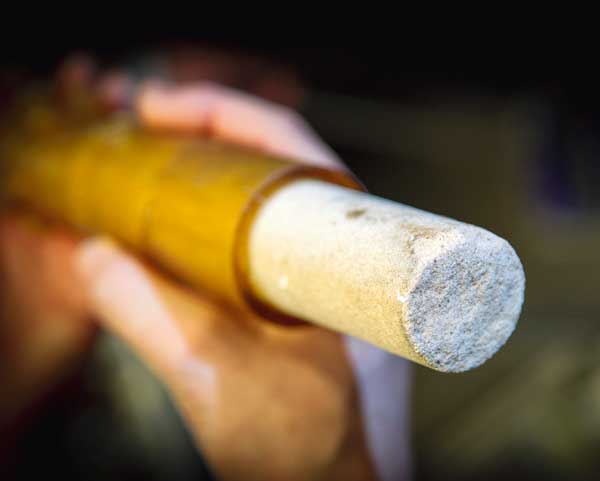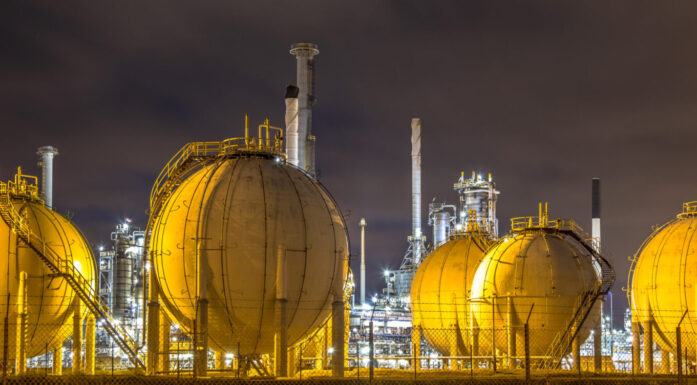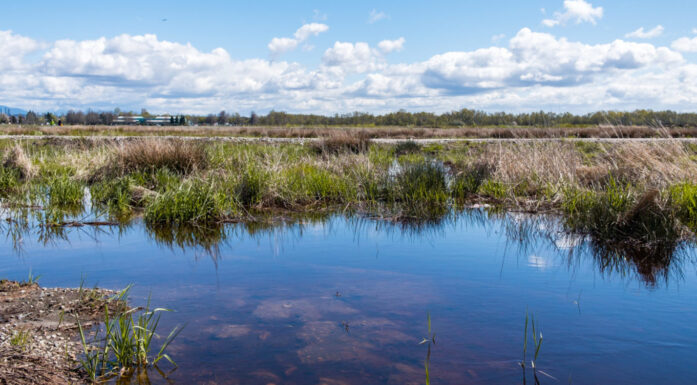Taking X-rays of CO2
A spongy sandstone deposit can help cool the Earth’s fever.
Perhaps all the talk of carbon trading, climate “moon landings,” and carbon capture and storage makes us forget that what we’re basically talking about is air. Air – what humans, plants, oceans and even plankton need to live.
It’s odd to think that we live at a time when the world’s leaders have meetings to talk about how much air they need to buy. And that it is possible to make millions storing what amounts to used air. Oil companies have to pay about 55 euro for every ton of CO2 they store.
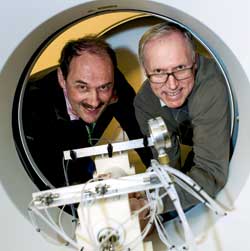
Sandstone can crack if it is filled with too much CO2. To be certain that this will not happen, NTNU Professors Martin Landrø and Ole Torsæter take X-rays of sandstone while it is being pumped full of CO2.
Photo: Ole Morten Melgård
But the reason is simple: if anything that lives and grows is exposed to too much CO2, this gas of life can become the gas of death.
Red Hot Evidence
CO2 is formed when any kind of organic material or fossil fuel, such as natural gas, petroleum, coal or gasoline, is burned. A cozy bonfire or a little fire in the wood stove on a cold winter’s day will add to the amount of CO2 in the atmosphere.
If you were in an area with a CO2 leak, you’d die of CO2 poisoning before you’d die of oxygen deficiency.
The Earth has a fever, and the gas of life is causing it. Perhaps that’s why the CO2 stored in the Earth looks in these images like a cancerous tumor, like a red-and-yellow ball of flame inside a grey mass of stone, sand and clay, red-hot evidence of the side effects of a Western lifestyle.
Checking for leaks
“I think it is important to remember that CO2 isn’t radioactive, but part of the air that we all exhale,” says Martin Landrø.
Landrø is a professor of petroleum engineering and applied geophysics at NTNU, and one of the world’s leading seismic experts – that is, in geophysical surveys of bedrock. Landrø has been engaged in monitoring underwater CO2 storage areas for more than ten years.
The goal of storing CO2 is to deposit it deep enough so that it becomes liquid. The gas needs to be buried under so many layers of sand and clay that it can’t escape, and stay encapsulated in a bubble under the sea forever.
But sometimes it doesn’t go according to plan. After a few years, the CO2 may begin to seep up and out. Sometimes small amounts manage to escape completely, appearing as small bubbles on the sea floor.
This is one of the reasons that the petroleum professors at NTNU have acquired a giant X-ray machine – a CAT scanner.
This particular X-ray machine has previously served its duty at St. Olavs Hospital, working steadily to reveal bone fractures and joint injuries. At NTNU it is being used to determine how much CO2 can be stored in various rock formations found under the sea. But taking X-rays of CO2 is not all that the professors are doing – they’re also measuring the speed of sound in different types of stone.
Patient – and pill
“This is our X-ray patient,” says Ole Torsæter, a professor of petroleum engineering and applied geophysics at NTNU, and holds up a small piece of sandstone.
But this patient contains its own medicine – the Earth’s own fever-reducing pill. This porous stone, found in abundance at the bottom of the sea, can store large amounts of CO2. Sandstone is porous, like a sponge – a sponge that oil companies can fill with CO2.
“Some sandstone can be filled with as much as 80 per cent CO2, while others can only hold about 30 per cent. These variations in capacity are exactly what we’re trying to figure out,” says Torsæter.
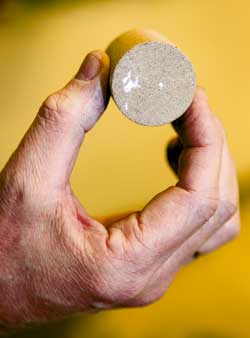
One of the planet’s fever-reducing pills: porous sandstone found in abundance on the sea floor.
Photo: Ole Morten Melgård
And here’s how they do it: they take sandstone and put it in water, so that all the pores are filled. They then put the stone into a thin, condom-like plastic cover. The cover has several holes in it that are sealed using microphones. The entire thing is then placed in a box that simulates the pressure in the seabed, which is then placed in the X-ray machine. As the X-ray scanner is on, the researchers inject CO2 into the rock, filling the porous stone with it and pressing out the water.
The X-ray images show how much CO2 has penetrated the rock’s pores. Since CO2 has a different density than water, the speed of sound will be slower when the rock is saturated with CO2. Therefore, the researchers measure the speed of sound in the rocks, watching how it changes as CO2 enters the pores. The goal is to fill up the stone without cracking it.
Two years of CO2 emissions
“If the pressure in the stone is too high, it can crack. To relieve the pressure we need to remove the water, the same way a doctor would drain fluid from a patient’s cyst. We do that too. When Co2 is injected into the seabed, sometimes we need to remove the water being pressed out of the rocks through a new well,” say Landrø and Torsæter.
It has now been 14 years since the first CO2 was injected into a seabed formation in the North Sea. Since then, Statoil has stored more than 12 million tons of CO2 in such formations. In 2011, the Norwegian Petroleum Directorate presented an atlas showing that Norway may be able to store as much as 50 gigatons of CO2 in geological formations under the sea. Annual global CO2 emissions are usually about 30 gigatons, meaning that Norway may be able to store almost two years of global emissions under the North Sea.
Norway is responsible for 0.17 per cent of global CO2 emissions. China accounts for 23 per cent.
Consumers are key
“I think it’s important to look at it from a practical standpoint. Storing CO2 in geological formations under the sea may be a good alternative to sending it straight into the atmosphere. If we do that, some of it is absorbed by the ocean anyway, so it is better store it under the sea, even though small quantities may still seep out,” says Landrø.
Consumers account for the largest emissions worldwide, he says: Heating and electricity generation account for about 40 per cent of global CO2 emissions, while transportation accounts for 25 per cent.
“This means we as consumers can help to determine how much CO2 is emitted,” Landrø says. “That’s one reason why I bike to work every day.”
